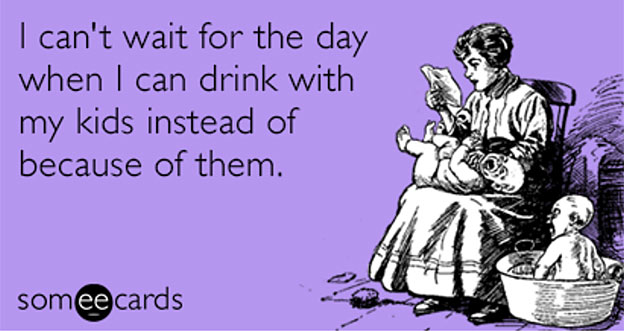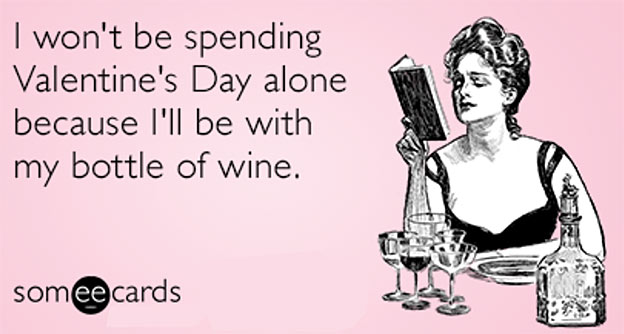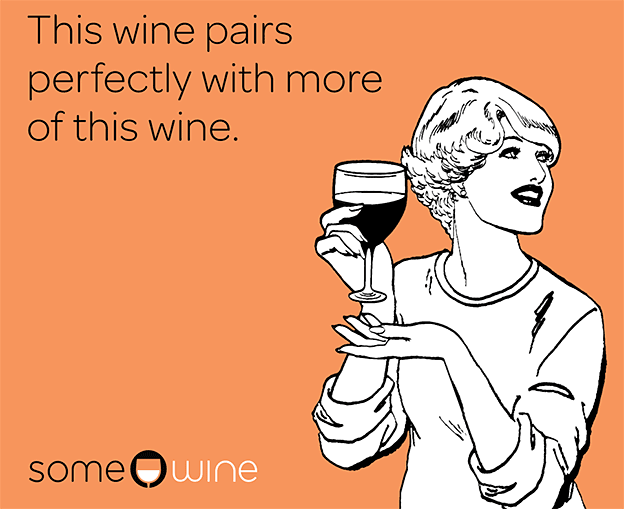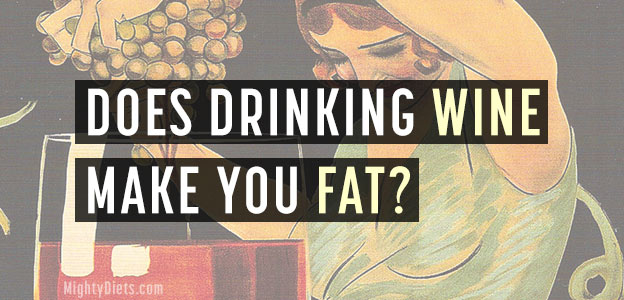Does wine really make you fat? Wine. Many of us love it, some people swear by it, but it definitely comes with a mixed bag of reviews when it comes to the question of its health benefits and whether or not its responsible for your trousers getting a little bit tighter.
In the interest of being all informative, here’s some interesting info we found out about wine which can help you beat the bloat when it comes to having a cheeky glass or two.
Wine: Calories per glass | Carbs per glass
Why Does Wine Make you Gain Weight?
Whether we like it or not, wine is alcohol and alcohol is known to cause havoc with our metabolism. Though there is no fat in wine, when we drink alcohol, our bodies try their hardest to metabolize it, use its energy and get rid of it. Unfortunately for us, this means that when you start having a few nibbles with your vino (cheese is usually a fatty culprit), your body will not process any of the food you’ve eaten until it’s broken down and used the energy in the alcohol.
It has also been reported that after drinking alcohol we can eat up to 30% more food than we normally would. So, we need to be a little more vigilant before going in for that extra serving of fries or dinner rolls.
Wine Has No Nutritional Label, So Check the “ABV”
Because wine doesn’t come with a nutritional label, it’s hard to tell exactly how many carbs and calories are in a glass. The best way to estimate is by looking at the “ABV,” or alcohol by volume on the label or back of the bottle.
Generally the higher the alcohol content of the wine, the more carbs, and calories.
Pure alcohol has 7 calories per gram but contains no carbs, which have 4 calories per gram. This means that alcohol is about twice as fattening as carbs, and wine with a lower alcohol content will have fewer calories. For this reason, aim for an ABV of about 10-12% if you want to consume fewer calories.
Dry wines that usually have a higher alcohol content include Zinfandel, Amarone, and Shiraz.
Tip: Sweet Wine Has More Calories Than Dry Wine

The amount of alcohol is important in estimating calories, but so is the sweetness. As a rule, sweeter wines have more sugar which means more calories and carbs. That means sweet sparkling wines and Champagne should be avoided, as they typically can have about 175 calories per glass.
If you are looking to celebrate with some bubbly, look for brut nature varieties of Champagne, sparkling wine, and Cava (Spanish version of Champagne.)
Even though a bottle of wine doesn’t give you calories and carbs, we can make some estimates based on the “varietal,” or kind of wine.
White Wine: Calories Per (5 oz.) Glass
Here’s how many calories are in a glass of white wine:
- Chablis: 110 calories
- Chardonnay: 120 calories
- Pinot Grigio: 110 calories
- Reisling: 115 calories
- White Zinfandel: 110 calories
Red Wine: Calories Per (5 oz.) Glass
Here’s how many calories are in a glass of red wine:
- Burgundy: 125 calories
- Cabernet Sauvignon: 125 calories
- Merlot: 125 calories
- Moscato: 130 calories
- Sangria: 145 calories
- Pinot Noir: 125 Calories
- Zinfandel (Red): 125 calories
Red Wine Has (Slightly) More Calories Than White
White wine and red wine typically have a similar caloric value. Though red wine tends to have more calories than white wine, as red usually contains more alcohol than white.
The typical number of calories in a 5 oz (150 ml) glass of wine is about 120-125, and a glass of wine will cost you 5 WW SmartPoints. Although red wine generally has more calories, take a look at the alcohol content (ABV) to determine whether that number is higher of lower. A dry wine with an ABV of only 9 will have about 102 calories per glass, while a sweet wine with an ABV of 14 will have about 142 calories.
As you can see, both red and white wines have about 120 calories per glass. Also. even though some types of wine have slightly more calories, they still have fewer calories than an average glass of beer which contains about 155 calories.
White Wine: Carbs Per (5 oz.) Glass:
Here’s how many carbs white wine has per glass:
- Chablis: 3.4 g carbs
- Chardonnay: 3.3 g carbs
- Pinot Grigio: 3.3 g carbs
- Reisling: 5.6 g carbs (sweet!)
- Sauvignon Blanc: 3.1 g carbs
- White Zinfandel: 4.2 g carbs
Red Wine: Carbs Per (5 oz.) Glass:
Here’s how many carbs red wine has per glass:
- Burgundy: 5.5g carbs
- Merlot: 3.6 g carbs
- Moscato: 6-8 g carbs (sweet!)
- Cabernet Sauvignon: 3.8 g carbs
- Pinot Noir: 3.3 g carbs
- Shiraz / Syrah: 3.8 g carbs
Sweet Wines Have More Carbs Than Dry Wine
Sweet wine has more carbs because of the higher sugar content. Still, it’s relatively low in carbs compared to other alcoholic drinks like beer and cocktails. In fact, an average light beer has about 7 carbs, so as a rule wine is lower in carbs than beer.
Tip for Fewer Calories & Carbs: Choose Wines from Europe
Wines from France, Italy, and Germany tend to have less alcohol than wines grown in warmer climates. That’s because a higher climate increases the sugar content of grapes, leading to higher alcohol content in the wine.
These European countries are also stricter with regulating alcohol content, so you’re less likely to find wines with high ABV.
Weight Gain from Drinking Wine Likely Caused By Increased Appetite

It’s probably not worth spending more on exotic kinds of wine that save you a couple of carbs or 20 calories. Instead, know that drinking wine can lead to weight gain because it makes you feel hungry, and you’re likely to end up snacking.
So, how do you curb these “wine munchies?” Try eating a protein before drinking wine. Think mixed nuts or maybe some hummus with veggies. Having some protein in your belly will make you feel more full when you’re drinking wine.
Also, be sure to drink enough water, as it will rehydrate you and help flush the alcohol through your system.
Which Wines Won’t Make You Fat?
If you are counting points with Weight Watchers or on a diet like Nutrisystem or South Beach, you’ll know that drinking alcohol is generally frowned upon. (Related: Nutrisystem & Alcohol)
So, in short, if you’re on a diet you should drink no more than one glass of wine per day, and be mindful of snacking while or after you drink. (They actually had a whole WW meeting to discuss why we get cravings, and alcohol was a big reason.)
Also, in recent years, there has been a plethora of new ‘diet’ wines launched onto the market. For example, weight watchers have their own brand of wine, Cense, which is grown in New Zealand and is just 85 calories per glass.
Though this is a great way to cut back, experts have criticized the overall quality of such wines. This is because, in order to ditch the calories, something has to be cut out somewhere, right?
Producers either cut the sugar content or the alcohol content, which, overall has a detrimental result on the taste of the wine. They have been known to add water (also known as ‘Jesus Units’) to these wine products to reduce the alcohol content, meaning you get a substandard quality of the wine but for the same price that a normal bottle would cost you.

There is also another way to drop the calories on wine but is used less often because it is complicated and time-consuming. The technique of reverse osmosis can be used to reduce the alcohol content in the wine and thus reduce calories.
Overall, you can definitely choose to drink these wines, but the calorie deficit isn’t that great and more often than not, the health benefits you get from the ‘full-fat’ version are usually nonexistent. And, to be fair, for the sake of 35 calories, wouldn’t you just rather hit the treadmill for an extra couple of minutes?
A glass of wine has way fewer calories than a pint of beer. Also, relatively speaking, anything can make you fat, especially if you’re consuming excessively. Wine won’t make you fat if you drink in moderation as part of a healthy and balanced lifestyle.
*Related: How Many WW Points Per Glass of Wine? (Red, White)
Also Consider the Health Benefits of Drinking Wine!
As mentioned above, wine can have many health benefits, which you can usually only benefit from if you are drinking the real product (i.e. no calorie-cutting wine).
It’s been reported that women that tend to be light drinkers, i.e. don’t binge, but have the occasional glass or two with dinner, actually have a healthier BMI over long periods of time in comparison to those who either binge drink or try to go the teetotal route.
Wine is also bursting with antioxidants, and it’s not just red wine, white wine is actually known to have equal if not higher amounts of antioxidants than red wine. These antioxidants can even help you reduce your chances of getting cancer, according to a study carried out at Harvard.
Wine is also great for the immune system and is perfect for warding off infections. This doesn’t mean we can drink gallons though, moderation is key or the opposite effect can happen. Wine has also been proven to reduce the risk of heart disease and of strokes and can even lower your cholesterol levels. Cognitive function has also been known to increase from just a single glass of wine and can prevent brain neurons from dying, reducing dementia rates.
So, what do you think? Does wine really make you fat? As part of a balanced lifestyle, we think not, the health benefits are overwhelming and as long as you aren’t binging and exercising regularly, wine can be the perfect accompaniment to your evening meal.
In Conclusion
At about 120 calories and 4g of carbs, a few glasses of wine a week won’t make you fat. If you are on a diet, know that white wine has slightly fewer calories, and be mindful that a higher alcohol content equals more calories.
Probably the most important thing to remember is that it’s not the glass of wine that’s high in calories, it’s the food you’re snacking on while you drink!

